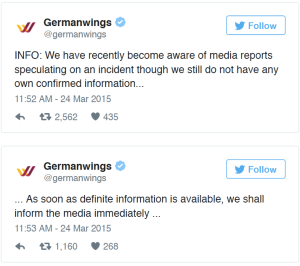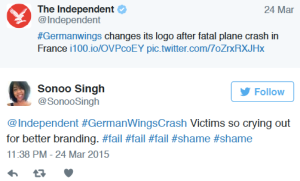Crises have the potential to damage the reputation of the organization and the relationships with stakeholders.
Therefore, it is important for organizations to anticipate and plan for possible crisis scenarios, preparing the crisis communication plan and the digital engagement strategy.
Here, a general overview on how the Germanwings Company has managed its crisis communication strategy in terms of digital engagement, as a consequence of the crash flight number 9525, direct from Barcelona to Düsseldorf on March 24th, 2015.
Germanwings Flight 9525 was a low cost flight arranged that left from Barcelona El Prat Airport on 24 March 2015 at 10.01 and was supposed to land in Düsseldorf Airport by 11:39. However, some 40 minutes into the flight, the aircraft (an Airbus A320), crashed in the French Alps, after a rapid descent of 12.000 meters in just 8 minutes.
All passengers and crew’ members lost their lives in the crash.
The apex of the matter came out when, couple of days later, investigators revealed that the crash was deliberated.
In fact, it has been leaked that the co-pilot Andreas Lubitz intentionally committed suicide and that he had been suffering from depressive episodes.
‘Managing a crisis’ means knowing exactly which actions to take in order to solve the problem responsibly, using communication strategies as support.
A critical event typically emerges as a sharp and unexpected fact that disrupts an organization’s operations, exposing the company to a financial risk and threatening the reputation.
Therefore, it is necessary to establish the new relevance of the speed. Social media are the manifestation of a new era in the communication field and, consequently, crisis communication professionals need to understand how to strategically optimize these tools.
The key role of crisis origin in affecting publics’ preferred information form (social media, traditional media, or word-of-mouth communication) and source (organization in crisis or third party), which influences how publics anticipate an organization should respond to a crisis and what crisis emotions they are likely to feel when exposed to crisis information.
It took more or less 72 hours for Brice Robin, the chief Marseille prosecutor handling the investigation of the crash to state that copilot Andreas Lubitz wanted “to destroy the aircraft”. It took an additional 24 hours for German investigators to unveil the copilot’s health related problems and medical history. In comparison it usually takes ICAO Member State airline crash and accident investigation teams up to one year to publish a final report.
Moreover, maintaining credibility is a very challenging activity in the face of lack of time and information. As companies venture into unknown territory, statements – especially early on – must only acknowledge known facts. Even if companies must resist the temptation of making statements that can be disproved over time, it can be necessary give information if the crisis involves other parties.
Therefore, the main crisis communication management’s mistake was the lack in their engagement strategy.
Especially on Twitter we can see the glaring inadequacy of Germanwings communication management. The first post about the suspected crash seems to have been sent at 11:52 a.m., although the crash happened at 10:40 a.m.

The company sent people to their website to reach other news about the fact.
In this case however, the Germanwings closed itself in a media silence, which has been filled by information from other informants and channels.
Flightradar24 for example quickly posted the flight path, including a graph that showed the rapid descent before radar contact was lost.
Immediately following, the declaration of the French President Hollande, appeared on one of the most widely read German-language news Websites, saying that many Germans died in the crash.

In spite of what was going on the other media, the Germanwings airline was mute and looked entirely clueless.
Instead of start a proper communication process – more than 90 minutes after the crash – the company “retweeted” a statement by their “parent company” Lufthansa, confirming that the plane had been lost, thus committing another mistake.
Moreover, around the same time, and instead of providing information, they replaced their logo with a black and white version, giving the impression of different priorities and careless of victims.


At the end, the confirmation of the crash was posted in German on the Twitter’s Germanwings page after more than two hours from the crash. Also, only six hours after the crash the company released a short post in English.
As it has been stated, in an incident crisis such as an air disaster, with the tragic and emotional circumstances of loss of life, the first 24 hours are the most important.
The same crisis response content, depending on different forms of communication, can bring out a completely different individual interpretation.
At beginning, the first emotion is of shocks; the second is empathy for those involved in the impact.
When people are too emotionally involved in the tragedy, they start apportioning blame and anger comes if the organization is perceived to adopt a wrong engagement strategy. To manage with issues like an air disaster, the organization of interest can help prevent shock turning to anger by:
- Proactively supporting those impacted by the crisis, showing compassion and attention on the company media channel.
- The situation’s gravity must to be understood and communicated to the stakeholders. Identifying how much responsibility stakeholders attribute to the organization, the crisis can be ‘framed’, in order to minimize the damage to the company’s image or reputation. By owning up to a crisis and demonstrating the involvement of the organization to solve it, a company may minimize feelings of anger and frustration among stakeholders. This is the reason why a proper digital engagement strategy is fundamental, especially during crisis.
- Tell the truth explaining what happened, being always update and clear.
- Making quick and decisive actions as required, demonstrating control of the situation.
Therefore, presenting narratives can be effective in crisis communication. After reading crisis narratives, participants’ negative emotions against the company in crisis can be significantly reduced.
Also, organizations should react proactively, utilizing official social media channels to establish information authority and accessibility, especially if the organization is not the cause of the crisis. Therefore, organizations can play the important role of crisis coping facilitator in circumstances where publics are in need of information clarification and reduction of uncertainty and negative feelings. Crisis managers and communicators should consider presenting further information and even partnering with publics and third parties to cope with the crisis situation collectively.
REFERENCES
Cornelissen, J. (2014). Corporate Communication. A Guide to Theory & Practice. London. Sage publications.
Crisis management (2015). 7 crisis facts from the Germanwings crash. http://sittingduck.tta.it/crisis-management-7-crisis-facts-from-the-germanwings-crash/
Griffin, A. and Smith, J. (2015). Reflections on the crash of Germanwings Flight 9525. Regester Larkin. https://www.regesterlarkin.com/news/reflections-on-the-crash-of-germanwings-flight-9525/
Neagu, A.,2015. Emotions in the media: Germanwings air crash. Romanian Journal of Journalism & Communication, Vol. X, nr. 2, 5 – 11. http://econpapers.repec.org/article/fojjournl/y_3a2015_3ai_3a2_3ap_3a5-11.htm
Online Crisis Communications (2015). Germanwings. Corporate Media Service. Reuters Business (2015). Co-pilot suspected of deliberately crashing Gremanwings jet. http://uk.reuters.com/article/us-france-crash-idUSKBN0MK2U020150327
Social Media for Goods (2015). How Germanwings Failed at Crisis Communications. http://sm4good.com/2015/03/26/germanwings-failed-crisis-communications/
The New York Times_EUROPE (2015). Germanwings Crash Exposes History of Denial on Risk of Pilot Suicide. http://www.nytimes.com/2015/04/19/world/europe/germanwings-plane-crash-andreas-lubitz-lufthansa-pilot-suicide.html
Yang, S-U., Kang, M., Johnson, P. (2010). Effects of Narratives, Openness to Dialogic Communication, and Credibility on Engagement in Crisis CommunicationThrough Organizational Blogs. New York. Sage Publications.Communication Research XX(X) 1–25 http://crx.sagepub.com/content/early/2010/06/04/0093650210362682
Jin, Y., Fisher Liu, B., Austin, L. L. (2011). Examining the Role of Social Media in Effective Crisis Management: The Effects of Crisis Origin, Information Form, and Source on Publics’ Crisis Responses. New York. Sage Publications. Communication Research 2014, Vol 41(1) 74–94 http://crx.sagepub.com/content/early/2011/09/16/0093650211423918
Shin, W., Pang, A., Jung Kim, H. (2015). Building Relationships Through Integrated Online Media: Global Organizations’ Use of Brand Web Sites, Facebook, and Twitter. New York. Sage Publications. Journal of Business and Technical Communication 2015, Vol. 29(2) 184-220 http://jbt.sagepub.com/content/29/2/184.short?rss=1&ssource=mfr